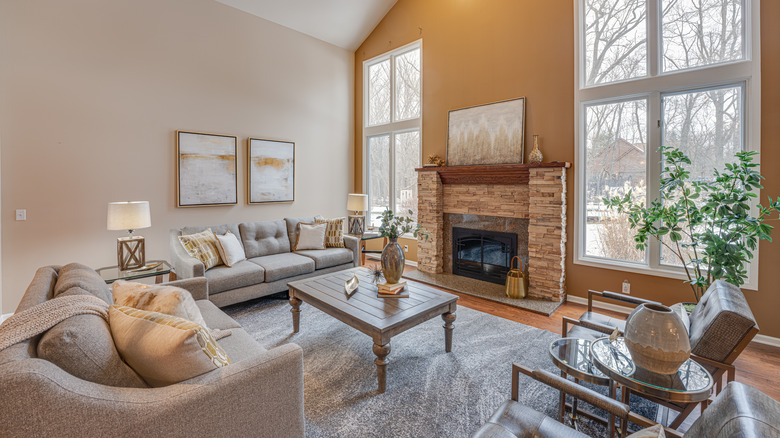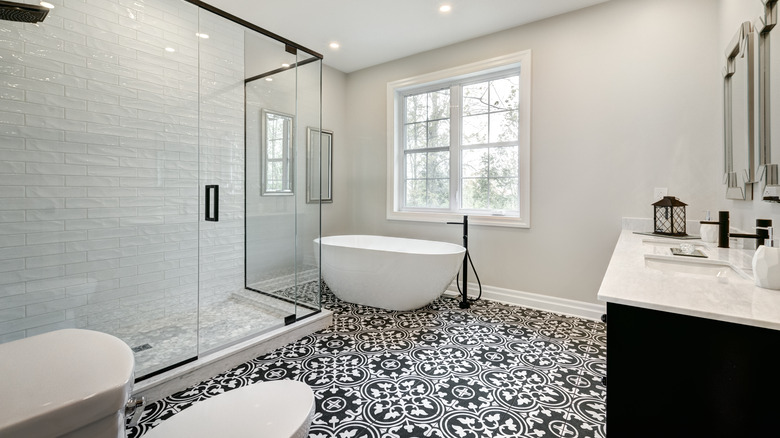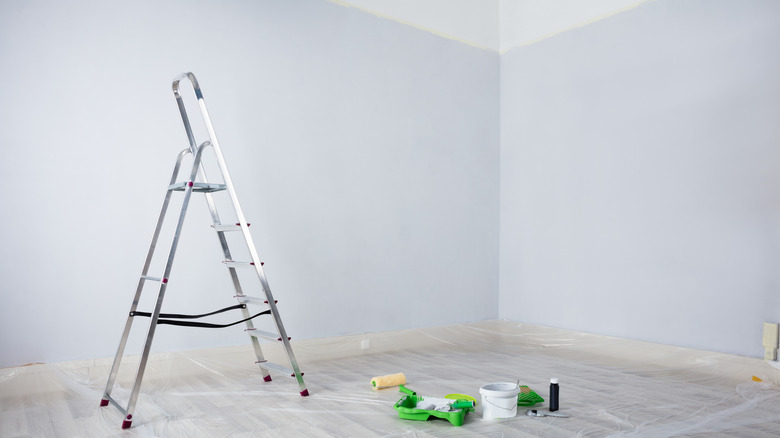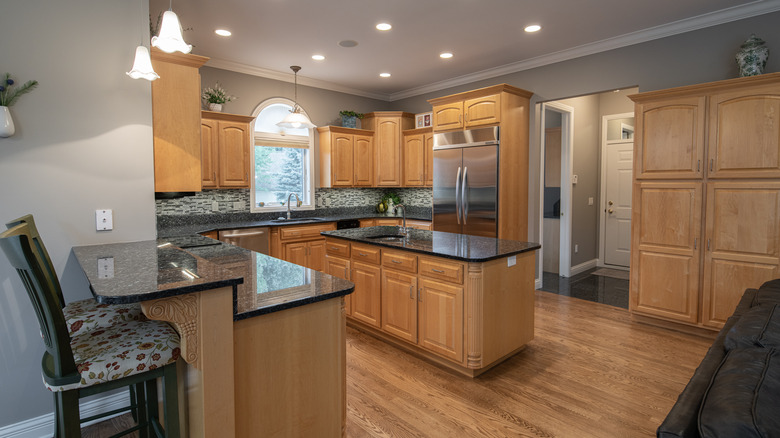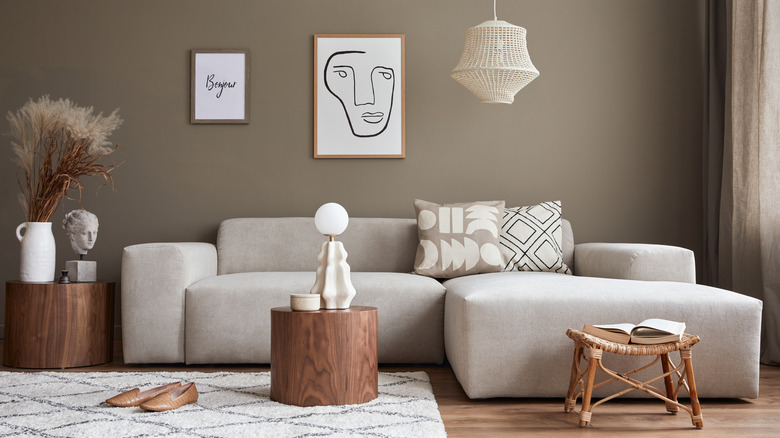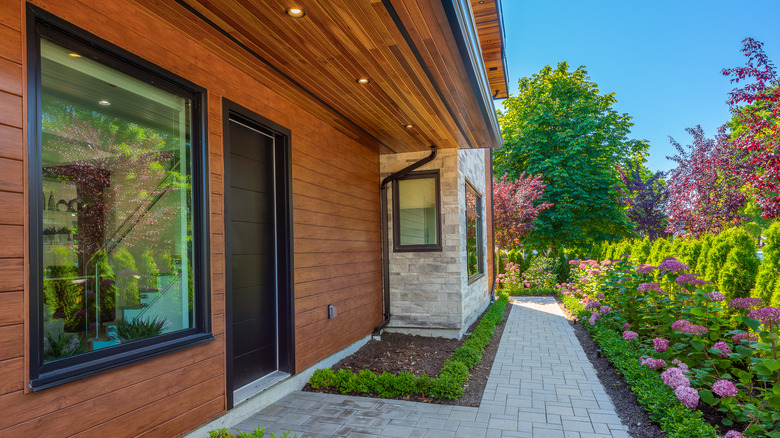5 Budget-Friendly Tricks For Staging Your Home
Staging your home is a time-tested method, both for increasing your home's value and shortening its time on the market. Potential buyers who tour an empty home may get a better sense of dimension and which of the rooms might get more sun and when. But rooms with no furniture and flat walls without objects to break up the blank space don't help engage their imaginations.
Once you have accepted that premise, your task becomes a good deal more manageable. Because even if you've built the home you're selling from the ground up, you've likely lived places where that wasn't so. What attracted you then? Was it the layout? The number of bedrooms and bathrooms? Think back to touring someone else's home and recall how you pictured yourself and your family living there. That's your starting place.
According to Investopedia, staging your home may be one of the best investments you'll ever make as a homeowner. The biggest mistake in the process is to regard staging as redecorating to show off how great your home looks when imprinted with your own personal taste and style. On the contrary: Your job is to help a potential buyer imagine how easily they could move into your home and have it adapt to them.
A variety of companies will come into your home and stage it for a fee. But, by paying attention to a few basics, you can do the work yourself and save a bundle — while also maximizing the profit in selling your home.
1. Deep clean
Clean, clean, and then clean your home some more. Nothing turns away a potential buyer like dust, dirt, or cobwebs. And while no one actually seeks to live in a dirty home, one person's disheveled is another person's idea of a pigsty. So the idea here is to take an unflinching look at the state of your home's cleanliness and even if you've been perfectly content with a dust bunny here or a carpet that attracts pet hair there, you have to imagine you're walking into someone else's house in a similar condition and that you're the one with the checkbook.
Keep in mind that this isn't a private referendum on you as a housekeeper; it's a packaging and marketing strategy that actually will boost your confidence as a seller as well as establish an early rapport with potential buyers, say the advisers at Moving.com. If you don't trust your own instincts, there are numerous maid services and deep cleaners who will show up at your door and do the work by the hour or for a flat fee.
This process also requires that you combine the skill sets of a detective and a drill sergeant. Imagine you're investigating your home. Where would be a sneaky place to check for filth? And then you can become that white glove inspector who won't accept anything but a place that's above reproach. Hints: Check underneath sinks, behind the toilets, in cupboards and corners, and around the refrigerator and stove. Now go clean.
2. Go neutral
Never underestimate the power of a freshly painted room. Some homeowners consider it work intensive; others think of painting as zen bliss. Either way, almost nothing telegraphs to a potential buyer that you care more than a fresh coat of paint. Think about it as they do: If the seller cares enough to paint, they're more likely to be people who take reasonable care of other parts of the house as well.
The pros at Bankrate suggest you stay within a limited color range and not veer too far from off-white (although actually, almost any color that you've picked a pale or neutral shade from will be an upgrade over not painting at all). Again, you're hoping that interested parties will be projecting their own imaginations onto the canvas that you've intentionally left more blank than full.
And, once you've moved your furniture away from the walls — leave it there. Potential buyers want to see what they're putting their money down for, not to have things hidden that might arouse suspicion. There are any number of ways to place furniture inside a room in order to leave the walls open for inspection. And some of these follow the ancient traditions of feng shui.
Lastly, have a look at your windows, inside and out. Some you may need a ladder to reach, but again, a few extra steps and a little elbow grease could add up to huge savings and a home sale that could well exceed your expectations.
3. Declutter everywhere
Think conceptually as you rid every room of objects that might be construed as clutter. You don't want kids' drawings on the refrigerator or a bowl with pet food on the floor. Wall art should be kept to the most basic and generic, and you absolutely don't want anything that's provocative or pulls focus away from the room you're trying to sell.
That's the intention here: You are trying to sell your home in every way that might appeal to someone who's interested. Sometimes a buyer is looking at the house and the outside and what's indoors as a whole; other times, people try to picture themselves going through life's routines from one room to another. You want to encourage them to do so at whatever level suits them.
And even if you choose to stage your home on your own, remember that you do have a partner who's just as invested in your success as you are: your realtor. Take full advantage of that person's advice for free as you make your way from room to room.
The professionals at The Close note that it's possible to hire your Realtor to assist in staging your home. But don't assume that they're experienced or trained to do so. And be advised that if you're working with a relatively new agent, it's likely they won't know much more about the process than you could learn from a quick internet search. But they can often provide a worthwhile second opinion.
4. Choosing furniture
There's no need to go overboard in staging. Choosing furniture that is fancier than the room it sits in is a dead giveaway that you're trying to fool the buyer. You wouldn't normally wear a gown or tie and tails to go out for a fast-food meal, so make sure your choices are appropriate to the surroundings, say the reporters at Forbes Advisor.
Also, in terms of furnishings, if your furniture is relatively new and amorphous, free of stains and signs of excessive wear, use it. No matter how sound the logic behind staging might be, it's still a gamble — although a smart one. By the way, statistically, some 80% of Realtors said they believe it makes a positive impact on potential buyers in a 2021 National Association of Realtors survey. In addition, 23% agreed that staging can increase offers from 1% to 5%, in contrast to homes that aren't staged.
Keep in mind too that you're not necessarily going to stage every room in your home. Focus on the ones that you think will have the most visual appeal. And that's something you can determine in two ways: One, what rooms do you think would be most attractive to the buyer? And two, what are the rooms with the most obvious visual appeal? Again, if you've found the right Realtor, they will almost certainly have an opinion on both of those topics.
From there, try keeping your plan affordable and appropriate.
5. Look outside
Lastly, check your curb appeal. You'll get only one chance to make a first impression, and if there are weeds or toys (or anything else that isn't organic), people touring your home are going to have doubts before they ever walk through your front door. And don't forget that most potential buyers will be scoping out your home online before they go to the trouble of arranging a walk-through. The last thing you want to do is turn them away before they've even got to see what you're selling.
There are a number of ways you can maximize your home's visual appeal from the street, according to Universal Class. Much of it can be done by hand with a lawnmower and a few hours pulling weeds or planting flowers. But you'll also want to direct your attention to the hard surfaces, too. Power washing can help brighten the places where you park, and even watering the lawn and hosing off your driveway before a showing can tell potential buyers you know company is on the way and you're prepared for it.
Beyond that, there's no one who doesn't like a well-manicured lawn. If you have a garden with either flowers or vegetables (or both), make sure you show it off to best effect by deadheading and trimming where it's needed. Even something as simple as edging your lawn has value.
Once your work's done, hide any evidence of hoses or sprinklers. Preserve the illusion you've created through your staging.
